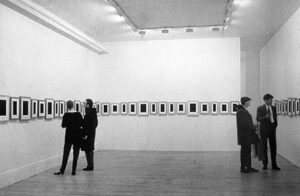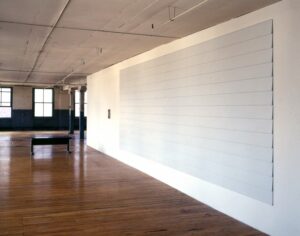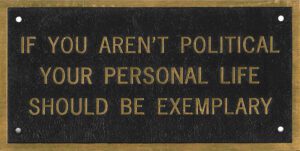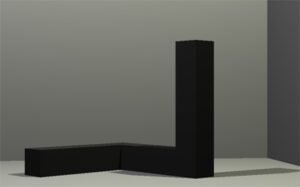Kathryn Hixson
From the Archives: This piece first appeared in the New Art Examiner in May 1991 with Derek Guthrie as Publisher and Howard Yana-Shapiro as Acting Publisher. Kathryn Hixson was a freelance writer living in Chicago contributing to Arts and The Journal of Art.
 Though American art produced in the 1980s and early 1990s deliberately, and satisfactorily, distanced itself from its Minimalist forebears, in the form of critiques of that movement’s hegemonic patriarchal rule and a grateful reinvestment in extra formal content and reference, many strategies and practices employed are based directly on suppositions inherited, wholesale, from the high Minimalist dictates of the mid-1960s. As has been noted elsewhere, several artists have actually used Minimalist practices to comment directly on its pitfalls, filling the seeming aridity of ‘specific object’ backup with possible reference. For instance, Felix Gonzalez-Torres’s corner candy spills and stacks of blank pages refer easily to the assumed prowess of the Minimalist gesture and its forbidding object, while elegantly unravelling the pomposity of the heterosexual male stands, so that the work can carry the artist’s more fragile homosexual eroticism. Tony Tasset also confronts the haughtiness of the Minimalist stance, making big, heavy rectilinear objects out of near invisible Plexiglas, or adding protective cardboard corners onto a bare white square, thereby asserting that the safeguarding of the Minimalist ideals is an essential to the legitimation of the object is art, as the object itself. However, beyond the straightforward quotes is an underlying current of Minimalist influence inextricable from current art making and the discourse surrounding it.
Though American art produced in the 1980s and early 1990s deliberately, and satisfactorily, distanced itself from its Minimalist forebears, in the form of critiques of that movement’s hegemonic patriarchal rule and a grateful reinvestment in extra formal content and reference, many strategies and practices employed are based directly on suppositions inherited, wholesale, from the high Minimalist dictates of the mid-1960s. As has been noted elsewhere, several artists have actually used Minimalist practices to comment directly on its pitfalls, filling the seeming aridity of ‘specific object’ backup with possible reference. For instance, Felix Gonzalez-Torres’s corner candy spills and stacks of blank pages refer easily to the assumed prowess of the Minimalist gesture and its forbidding object, while elegantly unravelling the pomposity of the heterosexual male stands, so that the work can carry the artist’s more fragile homosexual eroticism. Tony Tasset also confronts the haughtiness of the Minimalist stance, making big, heavy rectilinear objects out of near invisible Plexiglas, or adding protective cardboard corners onto a bare white square, thereby asserting that the safeguarding of the Minimalist ideals is an essential to the legitimation of the object is art, as the object itself. However, beyond the straightforward quotes is an underlying current of Minimalist influence inextricable from current art making and the discourse surrounding it.
The influences of Minimalism throughout the ‘Neo-Geo,’ ‘Neo conceptual,’ ‘Po Mo,’ ‘appropriationist,’ ‘deconstructionist’ works of the last decade are rampant enough, in self-conscious positioning as well as assumed predilections, that a discursive examination of these influences may somehow illuminate how Minimalism, though doomed at its hopeful revolutionary inception, set forth strategies and structures that remain compelling and useful. I use ‘Minimalism’ to mean strictly the brief moment of heady idealism and discourse surrounding the works, from 1965-69, of Donald Judd, Carl Andre, Dan Flavin, Robert Morris, Tony Smith, and Sol Lewitt, that privileged the phenomenological relationship between the sensate body of the viewer and the pared down barely aesthetic art object. Choosing to connect contemporary work to this particular slice of history may seem a highly artificial presumption, yet it is just this slice of Minimalism that has been commodified most cleanly, and is generally what contemporary artists have reacted against or in relation to. It is possible, though admittedly reductivist, to view much of the last decade of art making – in the midst of, and necessarily along with, the influences of French and German theory, feminism and sexuality, ethnicity, and critique of commodity fetishism – as a series of permutations on the more malleable Minimalist strategies and structures. And much of the discourse surrounding recent art – including my own – is rife with assumptions about ways to view and interpret work that are also structurally similar, if not identical, to Minimalist rhetoric.
The Body
The notion that the work of art is a coherent ‘body’ in space, with an inside and outside, having an anthropomorphic ‘presence,’ is the result of Greenburgian formalist dictates followed to logical ends by the Minimalists. In an effort to make the artwork totally non-referential, and completely self-referential, the Minimalist turn to sculpture because it purportedly has less tendency to carry illusion, making ‘objects,’ in contradistinction to the viewing ‘subject.’ In 1965 Barbara Rose described what she dubbed ‘ABC art’ as “elementary geometric forms that depend for their art quality on some sort of presence or concrete thereness, which in turn often seems no more than a literal emphatic assertion of their existence.” Michael Fried complained that the “apparent hollowness of most literal work… Is almost blatantly anthropomorphic,” and Robert Morris lorded it: “even in subtle morphological ways, object type art is tied to the body… Confined within symmetry of form and homogeneity of material.” The formalist urge had, as Barbara Rose added, “no wish to transcend the physical for either the metaphysical or the metaphoric… (it is) not supposed to mean other than what it is…”.This fusion of form and content is still given high marks, though heaps of referential reality have been added onto the side of content. Illusionism is employed only when loaded with scepticism, and many times work is judged in terms of ability to fulfil the desire for strong ‘presence.’ From Koons’s tchotchkes to Jenny Holzer’s mesmerising LED displays, and even Cady Nolan’s and Jessica Stockholder’s sprawling installation pieces, success is due in part to the cohesive ‘literal’ ‘thereness.’ The primacy placed by the Minimalists on immediacy of comprehension, as Rose says: “the all at once experience of the specific object,” has been slowed somewhat, but is still operative, as in Wendy Jacob’s breathing ceilings and walls, which, as their inflation and deflation is detected, clearly anthropomorphise the arid Minimalist presence in a succinct, direct physical manner.

Mitchell Kane, MOCA (1987)
Comment of the space
The primacy of the physical presence of the artwork in Minimalism was mirrored by the wish to make the viewer, the subject, aware of his/her own physicality in relation to the specific object in the specific space. As Fried noted, “the experience of literalist art is of an object in a situation – one that, virtually by definition, includes the beholder” (and therefore Fried, merely theatrical). Morris explained that “one is more aware than before that he himself is establishing relationships as he comprehends the object from various positions, and under varying conditions of light and spatial context.” No doubt influenced in part by existential literature, the Minimalists privilege the phenomenological subject as a participant in the art, in effect creating a new relationship (foreshadowed in post-painterly abstraction/scale) between the art object and the “beholder.” In previous work “what is to be had from the work is located strictly within (it),” and the viewer contemplated its inner logical relationships. With Minimalism, since it vigorously rejected any hint of complex relational composition and the object, the focus became the relationship between the physicality of the viewer in respect of that of the art.
Though this new relationship, at the time, activated the viewer beyond an idealised, transcendental contemplation/meditation, the artwork had the physical upper hand. Morris again: “the concerns now offer more control of the entire situation.” The contemporary obsession with presentation, rigidly controlled by the artist galleries, which finesses every aspect of the gallery or museum situation to create the open ‘proper’ atmosphere for viewing work, has clear precedents in Minimalist practice. Exhibits, be they large group shows in museums or individual artist’s gallery shows, are fashioned as, and critiqued, no matter what the media, as sculptural installations. Recent examples of the raucous ImageWorld show at the Whitney, which bombarded the beholder with visual, conceptual and aural information, mimicking cable TV, and The Body Show at the Renaissance Society in Chicago, where the installation led the viewer through a maze of little hallways, a darkened room, and dead-end open spaces so that the awareness of the viewer’s body affected the way the work – about the body – was witnessed.
The notion that the viewer, through bodily interaction, completes the work of art continues to be a crucial contemporary concern. The monumentalism of Minimalism’s dictates for the details of that completion, bound by the particular gender and class of those artists in the mid-1960s, have luckily been shattered by the literary crises of intentionality and interpretation, the floating signifiers of French deconstruction, and the feminist and ethnic exposition of the impossibility of uncultured autonomy. The relationship between the viewer and the art object has become much more of a multivocal conversation than a mere submission to univocal subjecthood. Yet there still is a direct connection to Minimalism’s preoccupation with the necessity of the physical presence, and manipulation, of the viewer for manufacture of meaning. Any recent art graduate student worth his/her salt insists that that work relies on what the viewer brings to it. Much of the most interesting recent work concentrates on exactly what expectations, assumptions, and preconceptions – housed in the beholder – are offered up to the work, almost regardless of what the work offers to the beholder.
Aggression

The Minimalist urge “to control the entire situation” of art viewing was symptomatic of the wish for the artwork to have an aggressive presence which commanded the viewer as well as the space of exhibition. Fried suggested that “literalist works of art must somehow confront the beholder – they must, one might almost say, be placed not just in his space but in his way.” In 1965 Barbara Rose described the work as “difficult, remote, aloof, and (as) indigestible as possible,” and in 1969 claimed that Minimalism “reject(s) nostalgia, charm, grace and nuance for bolder, more brutal qualities like power, impact and concreteness … The radicality of art is defined not in terms of its form, but in terms of its disruptive function…” This disruption of convention is the linear quest of the avant-garde, operable throughout the 20th century and fervently continued by the Minimalist, has been derailed as just another marketing strategy, but the aggressive desire to change, alter, shift, tamper with, or transform the viewer’s assumptions about a particular situation within the world and/or the art world, is a basic drive that informs contemporary art making, from the works of Richard Prince and Adrian Piper to those of Gretchen Faust and Judy Ledgerwood.
The overriding concern for control, to “allow no room for confusion or misrepresentation,” included a wish to control the critical discourse surrounding the work, and had Barbara Rose fishing around for a “relativist criticism which begins by determining context in which judgements can be made possible…” In contrast to “idealist absolutes and abstract standards” used to judge earlier work, e.g., Abstract Expressionism. Members of the post-war GI Bill boom, the college educated Minimalists, who were “intensely aware of what is happening in art and art criticism at this time,” spoke and wrote often about their work in the art periodicals, in a carefully controlled rhetoric that help to shape the experience of it. The current plethora of artists’ statements, artists writing criticism, and artists curating shows continues the Minimalist interest in participating in, not just reacting to, the critical discourse about their work. A clear, and rather ironic, example of this participation occurred in a recent collaboration between Andrea Fraser and Alan McCollum, wherein Fraser hired two actors to speak cogently and authoritatively about McCollum’s multiples, whenever a viewer strayed near, so that the criticism immediately influenced the interpretation of the work.
Truth to materials
Minimalists used the common materials of industry, rejecting the conventions of stone and chisel or paint on canvas, in order to ensure that their objects were not deceptions, were not delusions, but were ‘real.’ Minimalist truth to materials translated the Abstract Expressionist’s honesty towards paint into a spatial dimension, brought the cubist practice of collage into the gritty industrial milieu of the mid-1960s America, and joined the ranks of Duchamp and the Pop artists to “deal with basically unaesthetic material aesthetically.” This prime directive for work to be “materialistic… Because it’s made out of it so materials without pretension to other materials” has evolved into a similarly highly self-conscious choice of materials. Fine art media as well as found or manufactured objects are no longer chosen for their ability to be resistant to illusion, but rather for their capacity for evocative reference. A cabbage is a cabbage, a photograph must refer to its status as photograph, and a stuffed animal is just and only itself, but contemporary artists, just as the Minimalists chose steel and iron to reflect the techno-industrial landscape shaping their American terrain, exploit the extra aesthetic potential of their material to add meaning. Mike Kelly’s Minimal sculptures of blankets spread on the floor, topped with use stuffed animals, are explicitly true to their materials, where the ‘truth’ encompasses the nostalgic resonances of the materials’ history of use. Artists using living plants, or processes of decay of organic substances, are being quite true to their materials, and when illusionism is employed, such as in Vincent Shine’s finely crafted little neoprene plants, the artist is usually careful to clearly elucidate, on accompanying checklists, the exact chemical composition of the art object.
Permutations on a priori systems
To ensure that their sculptures be perceived ‘all at once,’ and reduce the possibility of authorial incident, the Minimalists employed a priori mathematical systems to dictate geometric shape, following Ad Reinhardt’s advice for “no accidents or automatism… Everything, where to begin and where to end should be worked out in the mind beforehand.” The emphasis on the conceptual aspects of the work seems to have evolved out of the post-painterly abstract artists’ formalist obsession with the givens of their medium – that the physical stretchers and canvases came to define ‘paintingness’ as and an a priori subject of painting. The Minimalists three-dimensionalized the systematic painting of Frank Stella or Barnett Newman into a serialism pursued most completely by Sol LeWitt. The ensuing two decades of conceptually based work is an obvious outcome of Judd’s and Andre’s precise geometries and the underlying scepticism towards ‘art’ systems quickly grew to encompass doubt towards every other system in a way that actually resuscitated art-making from the very death throes of Minimalist formalism.
The practice of setting up an a priori system is widely used today much in the same way that Lawrence Alloway distinguished systemic work from earlier art forms: “in style analysis we look for unity within variety; in One-Image art we look for variety with inconspicuous unity.” Sherrie Levine’s game boards, Richard Prince’s collections of motorcyclists and jokes, and Alan McCollum’s multiples are just a few examples of the new systemic approach. Artists have set up severely restrictive conditions for working, such as Gaylen Gerber, who continues to paint the same still life in the same hues on the same size canvas. Peter Halley has consistently sustained interest within a very narrow range of geometric forms and hues. Strict dependency on given systems has loosened up to include the critique of the chosen systems, and less emphasis is placed on Rinehart’s ‘where to end,’ than on the process leading up to it, as in Liz Larner’s petri dish cultures, now carefully drilled for safety, which rely on on a priority selection of a given process, though the specific outcome is impossible to predict.

Illusionism is fiction
Central to the Minimal urge was the necessity to expunge all illusionism from the work of art, refusing to participate in the production of what the artists at the time believed to be morally reprehensible fictions. The resulting Minimalist ‘truth’ has been so resoundingly co-opted and exploited by so many manipulators that it’s become more a ground that absorbs anyone’s fiction, but the urge to expose fictions is still crucial to contemporary work.
Distrust of illusion has permutated into a feminist discourse, which continually struggles to uncover the mechanisms that sustain the power of the status quo. Sherrie Levine’s elegantly Minimal gesture of rephotographing works by male members of the art canon and presenting them as her own, severely shook up the monumental claims of originality and authenticity hypostatized in art history, leaving a few shards of hollow legitimation floundering around in search of an aura. Jeanne Dunning’s untitled holes, backs of heads, and other isolated body parts conflate the truth value of the photographic representation with its pictorial ability to remain resonantly ambiguous. In her systematic recreation of a body as type or model, Cindy Sherman unapologetically continues to define herself as an endless accumulation of fictions. Also following in the traditionally Minimalist hunt for lies, Hirsch Perlman recently took on one of the most honoured locations of truth – the law, unravelling it into nonsensical poetry in order merely to present the beholder’s indefatigable desire to hunt down and arrest are given ‘true’ meaning.
Sociopolitical critique by materials of ascending power/systems of control
The Minimalists in the mid-1960s directly critique the privileged upper class status of previous forms – again joining with Pop to complete the Duchampian gesture – hoping to offer “a neutral pleasure of seeing known to everyone,” in “metaphor for ideally levelled non-stratified democratic society” that would be critical of “the commodity status of art in a materialist culture” in a way that “heralded reaction against the appropriation of art as an investment security.” Carl Andre claimed his work was “communistic, because the former is equally accessible to all men.” Fried noted that literalist art wishes to be taken ‘seriously,’ but parenthetically belittled that wish: “(certain modes of seriousness are close to the beholder by the work itself, i.e. those established by the finest painting and sculpture of the recent past. But, of course, those are hardly modes of seriousness in which most people feel at home, or that they even find tolerable).” The Minimalists use the middle-class materials of industrialism to reject fine art snobbery, and react directly to the sociopolitical situation at hand, where “Vietnam, technological development, sociology, and philosophy are all subjects of immediate importance.”
Since then, of course, the cool ‘anonymous’ international style of the Minimalists has become synonymous with maintaining, not dislodging, the dominant power structure of a global industrial complex. But at the time, the artist embraced the materials which were being used by an ascending structure of control. Likewise, artists of the 1980s and 1990s, reacting to the changing sociopolitical situation, continue to employ materials and vocabularies of ascending power relationships. As the Minimalists felt that identification with the architectural industrial complex afforded them a new potency to widen the field and heighten the critical effectiveness of art, ensuing generations of artists have adopted the tools and strategies of those contemporary forces which wield power in public and private spheres. Appropriating the structures of mass communication and advanced technology to reveal the mechanisms by which they maintain control, artists focus on the collusions between advertising and entertainment, the news media and government/business, the political manipulation of opinion, and the coercion of architecture in order to comment on the requirement to constantly fuel/fill the endlessly emptied market of the post-capitalist economy.

Museum of Modern Art, New York City
Currently the ‘image’ reigns supreme over any actual commodity, and the image of a strategy is what contemporary artists have offered. By making visible those mediating structures which actually prop up the seemingly unified image, these artists expose the process of image maintenance in our culture, which operates by collapsing the complexities of the consumer. Jenny Holzer and Barbara Kruger employ sloganeering, mimicking the best trademarked ad bites; Mike Kelly plays on a nostalgia in a way similarly as perverse as the advertising recall of the better days of the Good Housekeeping mum; and Nayland Blake manipulates camp in a way that would make any record promoter proud. Jeff Koons has tried to tap directly into the personality cult of the American media star. Richard Prince’s Marlboro Man, the epitome of the conservative American male, has now been most effectively replaced in the popular culture with Michael Jordan, the new role model for a new generation of multiracial customers.
The most significant difference between contemporary borrowing from the wider dominant culture and the Minimalist use of architectural materials and forms is that artists and critics have learned, by watching what happened to Minimalist work, that appropriation is a very complex strategy. Artists now are critical of what is being appropriated, and the structures of its control, often including an auto-critique of the very act of appropriation. Another difference between the generations is that the systems of power are located in a wide array of existing structures – from the documentary photograph, the news media, gender definition, and racial stereotyping, as well as architecture, interior design, and politically correct posturing – and empowered by a much wider array of people. Artists wilfully adopt the vocabularies of a dominant culture that promotes stereotyping, but subvert and expose the structures in such a way as to fly their ideas into the face of that Dominion. There is a danger that the ‘marginal’ or ‘eroticised’ voice will in turn, like Minimalism, become the latest fashionable art form, and as with Minimalism, any possibility of political content will be eradicated. But conversely, perhaps these voices are the ascending power.
Volume 35 no 2 November / December 2020

